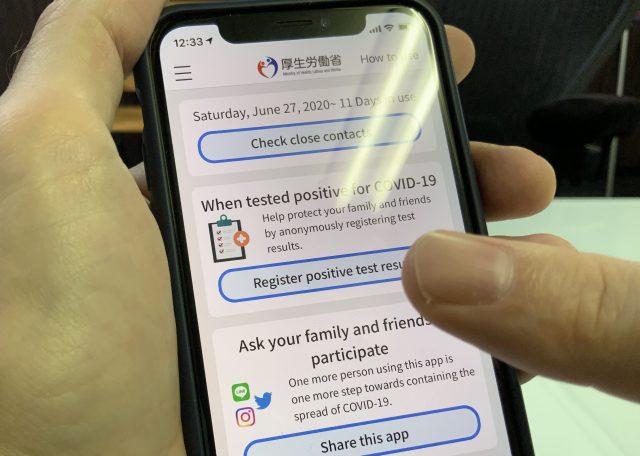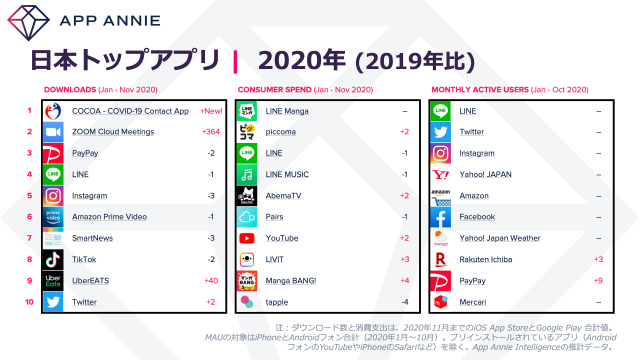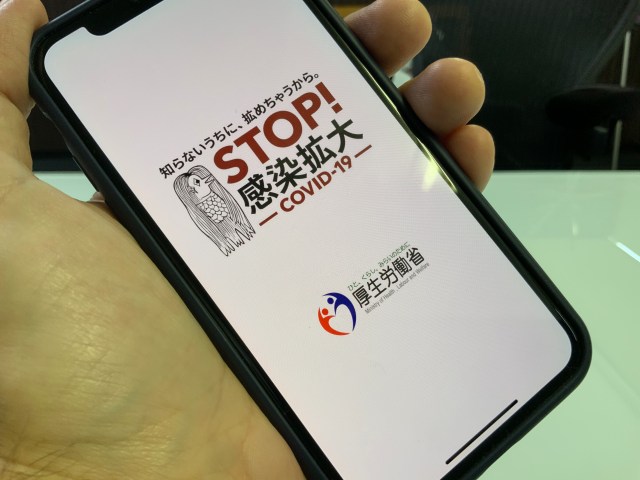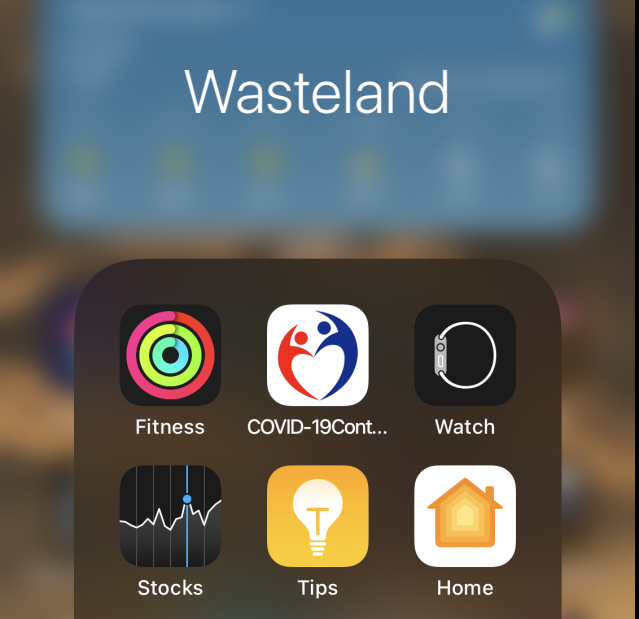
It’s not like we needed it or anything.
Hey everyone, do you remember COCOA?
Of course you don’t. While the most popular answer is probably the beans that make chocolate, in all-caps it’s the COVID-19 Contact Confirming Application, a 41-million-yen (US$390,000) contact tracing app that the Ministry of Health Labor and Welfare released last June.
The way it works is simple: By installing the COCOA app on your smartphone it automatically and anonymously keeps a record of other COCOA users that you come within one meter of for more than 15 minutes. Then, if one of those people tests positive for COVID-19 in the following two weeks, your phone receives a notification that you should get yourself checked out too.
The way it doesn’t work is also simple: For this system to effectively contribute to the reduction of infections, roughly 60 percent of the population would have to have it installed and functioning. This means it would have to be vastly more downloaded than the likes of TikTok, Instagram, and basically any other app in existence, which it made a surprisingly good attempt at.

App Annie Japan crowned COCOA as the most downloaded app of 2020, and according to the ministry it has been downloaded 24.64 million times as of 3 February, 2021. While those numbers would make any app developer drool, it still only amounts to 19.5 percent of the population, in the highly unlikely scenario that each download was made by an individual person and it is still installed on their phone.
I too did my civic duty and downloaded COCOA last summer. There it sat, dormant along with my Stocks and Fitness apps in the “Wasteland” folder.
I never heard so much as a bleep from it since, which I assumed meant I was being super safe during these hazardous times. However, as cases exploded over the winter, some people started noticing that their COCOA apps weren’t pinging even though people they knew were coming down with COVID-19. Others who were infected had trouble registering it in their own app.
As more and more reports of this came into the ministry, an investigation revealed that an update they released last September caused COCOA to not work properly on certain Android devices. Apps on iOS were said to be completely unaffected by the problem, and a fix should be ready by mid-February.
▼ An apology press conference was held by health minister Norihisa Tamura and a densely packed group of reporters.
It is not clear which ones or how many, but Android users account for 31 percent of COCOA downloads. This means as many as 7.7 million COCOA apps might have been rendered useless throughout the entire third wave of infections.
I’m at a loss for words, so let’s see what others had to say:
“…Hey!”
“This…I’m speechless.”
“That’s horrible.”
“Um…Isn’t it too late now?”
“What the hell? I installed COCOA on all my company’s phones, and they’re all Android.”
“Why are they so bad at this?”
“So, it’s okay if Android users get infected?”
“Huh…But if this was such a problem, wouldn’t they have noticed it earlier when the traffic of notifications changed dramatically as a result?”
Indeed, it’s not so much the mistake, since bugs in apps are a part of our daily life, but not noticing something like that for over four months is quite amazing. As the last comment suggested, it means that the problem wasn’t so big, the app isn’t so useful, or both.
Considering about 10,000 of the total 377,000 cases that occurred since COCOA was released were recorded in the app, the answer is pretty clear and we all better start blowing up our inflatable face shields.
Now if you’ll excuse me, I’m going to check if my Stocks app is actually working or not.
Source: NHK, Yomiuri Shimbun, PR Times, Hachima Kiko
Images: ©SoraNews24 (Unless otherwise noted)
● Want to hear about SoraNews24’s latest articles as soon as they’re published? Follow us on Facebook and Twitter!



 Only three COVID-19 infected people registered on Japan’s contact tracing app after a month
Only three COVID-19 infected people registered on Japan’s contact tracing app after a month Japanese government is shutting down its COVID contract-tracing app
Japanese government is shutting down its COVID contract-tracing app REVIEW: Samsung’s new fitness gadget makes a sleek smartwatch
REVIEW: Samsung’s new fitness gadget makes a sleek smartwatch Young people in Tokyo to be offered points and discounts if they get vaccinated
Young people in Tokyo to be offered points and discounts if they get vaccinated Four feel good stories about Pokémon Go that are the very best, like no story ever was
Four feel good stories about Pokémon Go that are the very best, like no story ever was Red light district sushi restaurant in Tokyo shows us just how wrong we were about it
Red light district sushi restaurant in Tokyo shows us just how wrong we were about it Pokémon Sleep camping suite and guestrooms coming to Tokyo Hyatt along with giant Snorlax burgers
Pokémon Sleep camping suite and guestrooms coming to Tokyo Hyatt along with giant Snorlax burgers Japan’s massive matcha parfait weighs 6 kilos, contains hidden surprises for anyone who eats it
Japan’s massive matcha parfait weighs 6 kilos, contains hidden surprises for anyone who eats it Tokyo Tsukiji fish market site to be redeveloped with 50,000-seat stadium, hotel, shopping center
Tokyo Tsukiji fish market site to be redeveloped with 50,000-seat stadium, hotel, shopping center Historical figures get manga makeovers from artists of Spy x Family, My Hero Academia and more
Historical figures get manga makeovers from artists of Spy x Family, My Hero Academia and more Akihabara pop-up shop sells goods made by Japanese prison inmates
Akihabara pop-up shop sells goods made by Japanese prison inmates Sandwiches fit for a sumo served up in Osaka【Taste Test】
Sandwiches fit for a sumo served up in Osaka【Taste Test】 Starbucks Japan adds a Motto Frappuccino to the menu for a limited time
Starbucks Japan adds a Motto Frappuccino to the menu for a limited time McDonald’s new Happy Meals offer up cute and practical Sanrio lifestyle goods
McDonald’s new Happy Meals offer up cute and practical Sanrio lifestyle goods Anime girl English teacher Ellen-sensei becomes VTuber/VVTUber and NFT
Anime girl English teacher Ellen-sensei becomes VTuber/VVTUber and NFT Japanese ramen restaurants under pressure from new yen banknotes
Japanese ramen restaurants under pressure from new yen banknotes All-you-can-drink Starbucks and amazing views part of Tokyo’s new 170 meter-high sky lounge
All-you-can-drink Starbucks and amazing views part of Tokyo’s new 170 meter-high sky lounge French Fries Bread in Tokyo’s Shibuya becomes a hit on social media
French Fries Bread in Tokyo’s Shibuya becomes a hit on social media Studio Ghibli releases new action figures featuring Nausicaä of the Valley of the Wind characters
Studio Ghibli releases new action figures featuring Nausicaä of the Valley of the Wind characters New private rooms on Tokaido Shinkansen change the way we travel from Tokyo to Kyoto
New private rooms on Tokaido Shinkansen change the way we travel from Tokyo to Kyoto Studio Ghibli glasses cases let anime characters keep an eye on your spectacles
Studio Ghibli glasses cases let anime characters keep an eye on your spectacles Beautiful Ghibli sealing wax kits let you create accessories and elegant letter decorations【Pics】
Beautiful Ghibli sealing wax kits let you create accessories and elegant letter decorations【Pics】 Studio Ghibli releases Kiki’s Delivery Service chocolate cake pouches in Japan
Studio Ghibli releases Kiki’s Delivery Service chocolate cake pouches in Japan New definition of “Japanese whiskey” goes into effect to prevent fakes from fooling overseas buyers
New definition of “Japanese whiskey” goes into effect to prevent fakes from fooling overseas buyers Our Japanese reporter visits Costco in the U.S., finds super American and very Japanese things
Our Japanese reporter visits Costco in the U.S., finds super American and very Japanese things Studio Ghibli unveils Mother’s Day gift set that captures the love in My Neighbour Totoro
Studio Ghibli unveils Mother’s Day gift set that captures the love in My Neighbour Totoro New Japanese KitKat flavour stars Sanrio characters, including Hello Kitty
New Japanese KitKat flavour stars Sanrio characters, including Hello Kitty More foreign tourists than ever before in history visited Japan last month
More foreign tourists than ever before in history visited Japan last month New Pokémon cakes let you eat your way through Pikachu and all the Eevee evolutions
New Pokémon cakes let you eat your way through Pikachu and all the Eevee evolutions Sales of Japan’s most convenient train ticket/shopping payment cards suspended indefinitely
Sales of Japan’s most convenient train ticket/shopping payment cards suspended indefinitely Sold-out Studio Ghibli desktop humidifiers are back so Totoro can help you through the dry season
Sold-out Studio Ghibli desktop humidifiers are back so Totoro can help you through the dry season Japanese government to make first change to romanization spelling rules since the 1950s
Japanese government to make first change to romanization spelling rules since the 1950s Ghibli founders Toshio Suzuki and Hayao Miyazaki contribute to Japanese whisky Totoro label design
Ghibli founders Toshio Suzuki and Hayao Miyazaki contribute to Japanese whisky Totoro label design Doraemon found buried at sea as scene from 1993 anime becomes real life【Photos】
Doraemon found buried at sea as scene from 1993 anime becomes real life【Photos】 Tokyo’s most famous Starbucks is closed
Tokyo’s most famous Starbucks is closed One Piece characters’ nationalities revealed, but fans have mixed opinions
One Piece characters’ nationalities revealed, but fans have mixed opinions We asked a Uniqlo employee what four things we should buy and their suggestions didn’t disappoint
We asked a Uniqlo employee what four things we should buy and their suggestions didn’t disappoint Princesses, fruits, and blacksmiths: Study reveals the 30 most unusual family names in Japan
Princesses, fruits, and blacksmiths: Study reveals the 30 most unusual family names in Japan App that buys your receipts crashes within hours of release due to too many users
App that buys your receipts crashes within hours of release due to too many users New app allows commuters to share info on train delays through Twitter
New app allows commuters to share info on train delays through Twitter Smartphone app finds empty restroom stalls in Tokyo subway station, makes pooing easier than ever
Smartphone app finds empty restroom stalls in Tokyo subway station, makes pooing easier than ever Handy portable battery charging service now available in downtown Tokyo for just 108 yen
Handy portable battery charging service now available in downtown Tokyo for just 108 yen SoraNews24’s loneliest reporter tests Japan’s new anime-style AI girlfriend smartphone app 【Vid】
SoraNews24’s loneliest reporter tests Japan’s new anime-style AI girlfriend smartphone app 【Vid】 COVID-19 cases plummeting in Japan, doctors puzzled why
COVID-19 cases plummeting in Japan, doctors puzzled why Tokyo’s busiest train stations have a new, free, English-compatible navigation app
Tokyo’s busiest train stations have a new, free, English-compatible navigation app Comiket returns! Japan’s largest otaku convention announced for 2021 with new admission policies
Comiket returns! Japan’s largest otaku convention announced for 2021 with new admission policies New Volcanic Japanese KitKats unveiled at star-studded Tokyo event
New Volcanic Japanese KitKats unveiled at star-studded Tokyo event New app lets you traverse the streets of modern Tokyo and ancient Edo at the same time
New app lets you traverse the streets of modern Tokyo and ancient Edo at the same time App lets you dance til you drop in Tokyo, with unlimited access to nightclubs for a flat rate
App lets you dance til you drop in Tokyo, with unlimited access to nightclubs for a flat rate Start your day with a wake up call from Re:Zero’s Emilia or Rem!
Start your day with a wake up call from Re:Zero’s Emilia or Rem! New Japanese app bribes you with free coffee for putting down your smartphone when driving 【Vid】
New Japanese app bribes you with free coffee for putting down your smartphone when driving 【Vid】 Otaku app lets you shop from your phone with help of cute mascot
Otaku app lets you shop from your phone with help of cute mascot Want to become a virtual YouTuber? Now there are apps for that too!
Want to become a virtual YouTuber? Now there are apps for that too! aDanza: Japan’s wild music player app featuring dancing alpacas, sumo wrestlers and more! 【Video】
aDanza: Japan’s wild music player app featuring dancing alpacas, sumo wrestlers and more! 【Video】
Leave a Reply